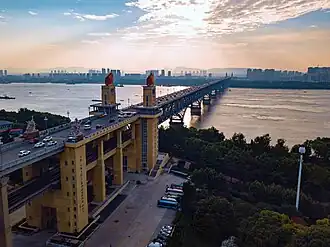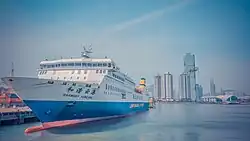Jiangsu Free-Trade Zone
China (Jiangsu) Pilot Free Trade Zone
中国(江苏)自由贸易试验区 | |
|---|---|
| Country | People's Republic of China |
| Province | Jiangsu |
| Cities | Nanjing, Suzhou, Lianyungang |
| Established | August 2, 2019 |
| Area | |
• Total | 119.97 km2 (46.32 sq mi) |
| Time zone | UTC+8 (China Standard Time) |
Jiangsu Free-Trade Zone (Chinese: 江苏自由贸易区), or China (Jiangsu) Pilot Free Trade Zone (abbreviated as Jiangsu FTZ, Chinese: 中国(江苏)自由贸易试验区) is a free trade zone located in Jiangsu Province, China, covering parts of Nanjing, Suzhou, and Lianyungang. It includes three main areas: the Nanjing Area, the Suzhou Area, and the Lianyungang Area, with a total area of 119.97 square kilometers.[1]
History

In September 2013, Jiangsu proposed two plans to establish a free trade zone. The first plan centered on the Suzhou Industrial Park Comprehensive Bonded Zone, integrating the customs special supervision areas in the five southern Jiangsu cities to build the free trade zone.[2] The second plan also focused on the Suzhou Industrial Park bonded zone but aimed to consolidate surrounding customs special supervision areas. However, the State Council rejected these proposals.[3] Subsequent proposals such as “Suzhou + Wuxi,” “Suzhou + Nantong,” “Suzhou High-tech Zone + Kunshan + Suzhou Industrial Park,” and “Suzhou + Lianyungang” were also rejected.[2]
After the approval of the Nanjing Jiangbei New Area as a national-level new area in June 2015, the Jiangbei New Area proposed applying for free trade zone status in November 2016. In January 2019, Jiangsu again submitted a proposal to establish the free trade zone, with a team of dozens who revised the application documents hundreds of times. Around this time, Jiangsu officials publicly discussed the potential establishment of the Jiangsu FTZ in Nanjing. In February 2017, representatives from Lianyungang suggested including the Lianyungang Free Trade Port Area as a core area in the Jiangsu FTZ in the next batch of free trade zones, with a planned area of 120 square kilometers.[4]

On August 26, 2019, the State Council officially approved the establishment of the China (Jiangsu) Pilot Free Trade Zone.[5] On August 30, the China (Jiangsu) Pilot Free Trade Zone was formally launched in the Jiangbei New Area of Nanjing. Lou Qinjian, Secretary of the Jiangsu Provincial Committee of the Chinese Communist Party, and Wu Zhenglong, Governor of Jiangsu Province, collaboratively inaugurated the plaques for the China (Jiangsu) Pilot Free Trade Zone, along with the sub-zones of Nanjing, Suzhou, and Lianyungang.[6] A project signing ceremony occurred on the same day. The administrative authorities of the Shanghai, Jiangsu, and Zhejiang Pilot Free Trade Zones executed the "Strategic Cooperation Framework Agreement for Coordinated Development of the Shanghai-Jiangsu-Zhejiang Pilot Free Trade Zones."[7] The Jiangsu Provincial Department of Commerce entered into cooperation agreements with six institutions, including the Chinese Academy of International Trade and Economic Cooperation affiliated with the Ministry of Commerce, to utilize think tank resources and collaboratively advance research on pilot free trade zones.[6]
On August 30, 2022, the Jiangsu provincial government held a press conference marking the third anniversary of the Jiangsu FTZ.[8]
Administrative Divisions and Functions
According to the State Council's approval, the Jiangsu FTZ covers three main areas totaling 119.97 square kilometers:[9]
Nanjing Area

The Nanjing Area covers 39.55 square kilometers entirely within Jiangbei New Area. It is bounded by the Yangtze River, Hengjiang Avenue, and various roads. Its development goal is to build an internationally influential innovation pilot zone, a modern industrial demonstration area, and an important platform for openness and cooperation.[10] The focus is on independent innovation, leveraging Nanjing's scientific talent and support policies to attract global innovation resources, creating an open international collaborative innovation and entrepreneurship base.[10][11]
Suzhou Area
.jpg)
The Suzhou Area covers 60.15 square kilometers (including 5.28 km2 of the Suzhou Industrial Park Comprehensive Bonded Zone), located entirely within the Suzhou Industrial Park. Its scope includes core areas such as high-end manufacturing, international trade zones, science and education innovation zones, business districts, and tourism resorts. The area aims to build a world-class high-tech industrial park and a high-standard, high-quality free trade zone focused on industry upgrading, innovation-driven development, and creating a competitive "2+3+1" industry system[12] (two leading industries: new generation information technology and high-end equipment manufacturing; three emerging industries: biomedicine, nanotechnology applications, artificial intelligence; plus modern service industries).[13]
Lianyungang Area

The Lianyungang Area covers 20.27 square kilometers (including 2.44 km2 of the Lianyungang Comprehensive Bonded Zone), encompassing parts of the Lianyungang Economic and Technological Development Zone, Lianyun District, and Lianyungang Port. The goal is to build an important Eurasian international transportation hub and an open gateway, serving as a cooperation platform for Belt and Road countries. The development focus includes advanced manufacturing such as biomedicine, new materials, new energy, and high-end equipment, as well as modern services like logistics, cross-border e-commerce, tech services, and financial services.[14]
See also
- Shanghai Free-Trade Zone
- Zhejiang Free-Trade Zone
- Yangtze Delta
- Strategy for Integrated Development of the Yangtze River Delta
References
- ^ "国务院关于同意新设6个自由贸易试验区的批复_对外经贸合作_中国政府网". 中国政府网_中央人民政府门户网站 (in Chinese). 2023-11-24. Retrieved 2025-07-22.
- ^ a b "江苏自贸区成功获批,江北新区迎来新利好". 新浪财经_金融信息服务商 (in Chinese). 2019-08-26. Retrieved 2025-07-22.
- ^ "江苏设自贸区尚在"调研"阶段 初步备选方案有两个". 经济·科技--人民网 (in Chinese). 2013-10-25. Retrieved 2025-07-22.
- ^ "连云港自贸区、江苏海洋大学、综合交通枢纽……港城代表很关注_江苏人大". jsrd.gov.cn (in Chinese). 2017-02-10. Archived from the original on 2019-09-01. Retrieved 2025-07-22.
- ^ "《中国(江苏)自由贸易试验区总体方案》". 中国一带一路网 (in Chinese). 2019-08-26. Retrieved 2025-07-22.
- ^ a b "中国(江苏)自贸区正式揭牌!娄勤俭就推进建设提3点要求". jres2023.xhby.net (in Chinese). 2019-08-30. Retrieved 2025-07-22.
- ^ "建成新时代改革开放新高地 中国(江苏)自由贸易试验区揭牌 四大项目签约落户苏州工业园区". 安徽长三角双碳发展研究院 (in Chinese). 2020-09-16. Retrieved 2025-07-22.
- ^ "江苏自贸区设立三周年:高质量完成各项目标任务". 中国一带一路网 (in Chinese). 2022-09-05. Retrieved 2025-07-22.
- ^ "6个新设自贸试验区正式揭牌 助力构筑开放新版图_国务院动态_中国政府网". 中国政府网_中央人民政府门户网站 (in Chinese). 2019-08-31. Retrieved 2025-07-22.
- ^ a b "5年形成200余项制度创新成果 南京自贸片区改革动能澎湃,发展成色更足_新华网江苏频道". 新华网江苏频道 (in Chinese). 2024-08-31. Retrieved 2025-07-22.
- ^ "关于中国(江苏)自由贸易试验区南京片区建设情况的报告_ 南京市第十六届人民代表大会常务委员会第二十五次会议_ 南京市人大". 南京市人大. 2021-06-09. Retrieved 2025-07-22.
- ^ "以制度红利谋定"一区四高地"". 澎湃新闻 (in Chinese). 2019-08-29. Retrieved 2025-07-22.
- ^ "江苏自贸区苏州片区落户园区". 澎湃新闻 (in Chinese). 2019-08-27. Retrieved 2025-07-22.
- ^ "江苏自贸区的第101天,重磅来袭". jres2023.xhby.net (in Chinese). 2019-12-10. Retrieved 2025-07-22.